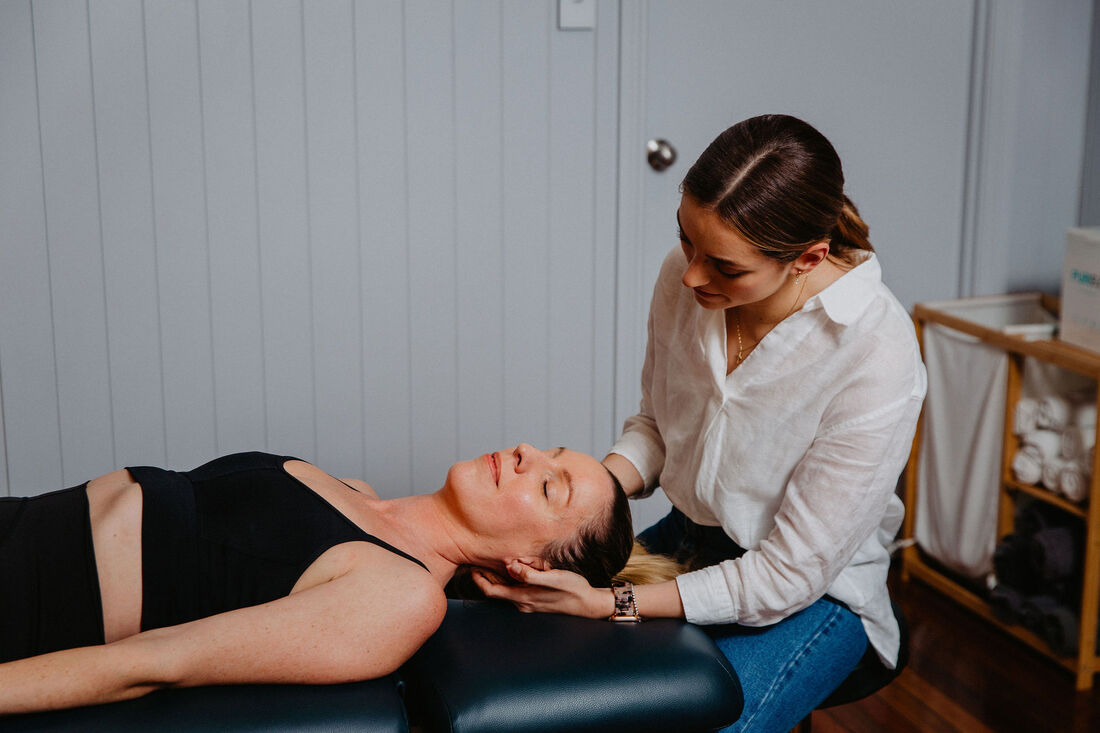TMJ physiotherapy Brisbane southside.
TMJ PAIN AND DYSFUNCTION AND OROFACIAL PAIN
Do you suffer from jaw pain, headaches, facial discomfort, or limited jaw movement? If so, you may be experiencing symptoms of temporomandibular disorder (TMD) or orofacial pain. Our clinic specialises in the diagnosis and treatment of these conditions and can help you get back to a pain-free, comfortable life.
Orofacial pain disorders
Orofacial pain disorders are very common problems that affect the head, face, and neck. This area is complex and has many muscles that work together to help you bite, chew, swallow, kiss, and talk. To figure out what's wrong and how to help, you may need multiple different health professionals might need to look at the problem from many different angles.
There are many different causes of orofacial pain disorders, including:
TMD can cause problems with the jaw and its muscles, which can be painful and limit movement. To treat TMD, health professionals will look at a person's medical history and their symptoms to figure out the best way to help.
Some symptoms of TMD include:
• Pain in the jaw, cheek, or near the ear
• Ear pain
• Tooth pain
• Dizziness or ringing in the ears
• Limited movement of the jaw
• Noises when opening or closing the jaw
• Clenching or grinding the teeth
• Headaches or facial pain
• Feeling pressure in the face.
Joint disorders in the jaw can also cause problems. They might involve problems with the disc that cushions the jaw joint, which can lead to pain and limited movement.
Joint Disorders of the TMJ
Some jaw joint problems involve changes in the disc that cushions the joint, leading to pain and limited movement. This can be caused by the disc moving out of place or due to muscle problems or inflammation in the joint. If the disc is out of place, it can cause pain and limit the movement of the jaw, making it difficult to open and close.
Our clinic offers a range of therapies to help alleviate your symptoms and improve your quality of life. These may include:
• Manual therapy to improve jaw mobility and reduce pain
• Soft tissue mobilisation to relieve muscle tension •
Muscle strengthening and stretching exercises to improve jaw function
• Joint mobilisation to improve joint alignment and reduce pain
• Education and advice on posture, sleep, and stress management
Don't let TMD or orofacial pain control your life. Take the first step towards relief and contact our clinic today to schedule your appointment. Our dedicated team is here to help you get back to doing the things you love
References:
Romero-Reyes, M., & Uyanik, J. M. (2014). Orofacial pain management: current perspectives. Journal of pain research, 7, 99–115. https://doi.org/10.2147/JPR.S37593
If you're suffering from jaw or face pain we're here to help! Call us on 07 3706 3407 or email [email protected] to make your appointment, or jump onto our bookings page below to book online.
Orofacial pain disorders
Orofacial pain disorders are very common problems that affect the head, face, and neck. This area is complex and has many muscles that work together to help you bite, chew, swallow, kiss, and talk. To figure out what's wrong and how to help, you may need multiple different health professionals might need to look at the problem from many different angles.
There are many different causes of orofacial pain disorders, including:
- Temporomandibular disorders (TMD), which affects the jaw joint and the muscles used for chewing.
- Nerve problems, like trigeminal neuralgia.
- Psychological factors, such as stress or anxiety.
TMD can cause problems with the jaw and its muscles, which can be painful and limit movement. To treat TMD, health professionals will look at a person's medical history and their symptoms to figure out the best way to help.
Some symptoms of TMD include:
• Pain in the jaw, cheek, or near the ear
• Ear pain
• Tooth pain
• Dizziness or ringing in the ears
• Limited movement of the jaw
• Noises when opening or closing the jaw
• Clenching or grinding the teeth
• Headaches or facial pain
• Feeling pressure in the face.
Joint disorders in the jaw can also cause problems. They might involve problems with the disc that cushions the jaw joint, which can lead to pain and limited movement.
Joint Disorders of the TMJ
Some jaw joint problems involve changes in the disc that cushions the joint, leading to pain and limited movement. This can be caused by the disc moving out of place or due to muscle problems or inflammation in the joint. If the disc is out of place, it can cause pain and limit the movement of the jaw, making it difficult to open and close.
Our clinic offers a range of therapies to help alleviate your symptoms and improve your quality of life. These may include:
• Manual therapy to improve jaw mobility and reduce pain
• Soft tissue mobilisation to relieve muscle tension •
Muscle strengthening and stretching exercises to improve jaw function
• Joint mobilisation to improve joint alignment and reduce pain
• Education and advice on posture, sleep, and stress management
Don't let TMD or orofacial pain control your life. Take the first step towards relief and contact our clinic today to schedule your appointment. Our dedicated team is here to help you get back to doing the things you love
References:
Romero-Reyes, M., & Uyanik, J. M. (2014). Orofacial pain management: current perspectives. Journal of pain research, 7, 99–115. https://doi.org/10.2147/JPR.S37593
If you're suffering from jaw or face pain we're here to help! Call us on 07 3706 3407 or email [email protected] to make your appointment, or jump onto our bookings page below to book online.
Who to book in with:
Yulia Khasyanova
|
Monica Hanna
|


